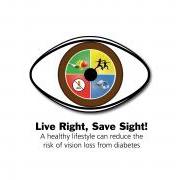More than 25 million Americans have diabetes. In addition to being the leading cause of kidney failure and non-traumatic lower limb amputations, it is the leading cause of new cases of blindness in those ages 20 and over. People with diabetes are also twice as likely to develop other eye diseases such as cataract and glaucoma. Fortunately, recent studies have shown that the onset of Type 2 diabetes can be delayed or prevented and the risk of vision loss reduced through a healthy diet and exercise.
As part of November’s Diabetic Eye Disease Awareness Month, Prevent Blindness Iowa is launching its new “Live Right, Save Sight!” campaign. The goal of the new program is to educate the public on diabetes and its potential effect on vision, as well as healthy choices they can make today to save sight in the future. Live Right, Save Sight! also provides free information including risk factors, treatment options and Medicare benefits as well as a dedicated web page at advocacy.preventblindness.org/diabetes.
Diabetic retinopathy is an eye disease that weakens the small blood vessels in the retina. Retinal blood vessels can break down, leak, or become blocked – affecting and impairing vision over time. In some people with diabetic retinopathy, damage to the eye can occur when abnormal new blood vessels grow on the surface of the retina. Diabetic macular edema is a result of diabetic retinopathy and can lead to loss of central vision.
There are two common types of diabetes. Type 1 accounts for approximately 5 percent of all diabetes cases and is usually diagnosed in children. It occurs when the pancreas is unable to produce insulin, an essential body requirement. Type 2 accounts for up to 95 percent of diabetes cases. This form of diabetes occurs when the pancreas does not produce enough insulin or when the body does not effectively use the insulin that the body does produce. Type 2 diabetes usually develops in adulthood, although increasing numbers of children in some populations are being diagnosed.
The diabetes epidemic that we are facing is very serious and the resulting complications from this disease can be devastating to our health. The good news is that by making a committed effort to leading a healthy lifestyle today, we can help delay or even prevent developing diabetes and its effects in the future.
As part of the Live Right, Save Sight! campaign, Prevent Blindness Iowa recommends:
-Visit an eye doctor at least once a year if you have diabetes or if you are at high risk. For some, diabetic retinopathy is one of the first signs of diabetes.
-Maintain a healthy weight – if you are overweight, even a modest weight loss can help prevent Type 2 diabetes.
-Increase your physical activity – exercising 30 minutes a day, five times a week can cut your risk of Type 2 diabetes by more than half. It is important to check with your doctor before starting an exercise program.
-Watch and control your blood sugar levels.
-Maintain a healthy blood pressure. High blood pressure increases the risk of eye disease, as well as heart disease, stroke and kidney disease. It may be necessary to change diet and exercise habits or take medication to keep blood pressure under control.
-Quitting smoking can significantly reduce the risk for diabetic retinopathy as well as provide other health benefits.
-All women who are pregnant or who are planning to become pregnant and have been diagnosed with diabetes should get a full, dilated eye exam.
Live Right, Save Sight!

